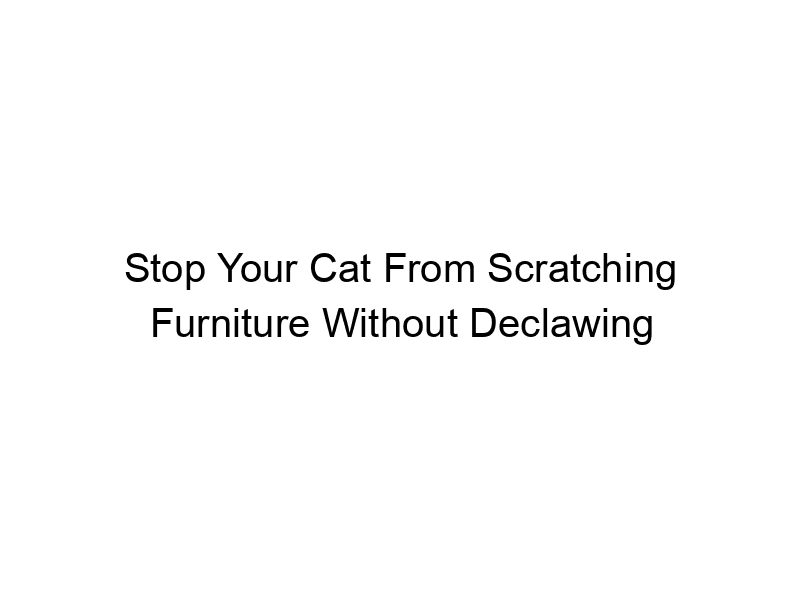Protecting your furniture while keeping your cat happy and healthy is a common concern for cat owners. This comprehensive guide explores various effective strategies to deter your feline friend from scratching your furniture without declawing, a cruel and often unnecessary procedure. We’ll delve into the reasons behind scratching, different deterrents, and the best ways to redirect your cat’s natural instincts towards more appropriate scratching posts. You’ll learn about training techniques, environmental modifications, and the importance of providing suitable alternatives. Let’s get started on creating a harmonious home for both you and your cat!
Scratching is an innate feline behavior with multiple purposes. It’s not just about sharpening their claws; it’s also a way for cats to mark their territory (through scent glands in their paws), stretch their muscles, and remove the outer sheaths of
their claws. Ignoring this natural instinct can lead to frustration and behavioral problems in your cat.
The Dangers of Declawing
Why Declawing is Cruel
Declawing is a painful and irreversible procedure that involves amputating the last bone of each toe. It’s akin to cutting off a human’s finger at the last joint. The pain and potential long-term complications, such as phantom limb pain, arthritis, and behavioral changes, are significant. Many veterinary professionals now strongly advise against declawing.
Providing Suitable Scratching Alternatives
Types of Scratching Posts
Offer a variety of scratching posts to cater to your cat’s preferences. Experiment with different materials (sisal, carpet, cardboard), heights (vertical, horizontal), and textures. Some cats prefer tall posts for stretching, while others prefer horizontal surfaces for a more comfortable scratching experience.
Placement of Scratching Posts
Strategic placement is crucial. Place scratching posts near areas where your cat likes to scratch, such as near furniture they currently target. Make them easily accessible and attractive by placing catnip or treats nearby. Don’t force your cat to use the post; let it discover it naturally.
Training Your Cat to Use Scratching Posts
Positive Reinforcement Training
Use positive reinforcement techniques. When your cat uses the scratching post, immediately reward them with treats, praise, or a favorite toy. This positive association will encourage them to use the post more frequently. Consistency is key.
Redirecting Scratching Behavior
If you catch your cat scratching furniture, gently redirect them towards the scratching post. Say “No!” firmly but kindly, then immediately guide them towards their post and offer a reward when they start scratching it.
Deterring Scratching on Furniture
Making Furniture Less Appealing
Use deterrents such as sticky tape (double-sided tape is effective), aluminum foil, or plastic sheeting on the furniture to make scratching less appealing. The unpleasant sensations will discourage your cat from scratching those surfaces.
Cat-Proofing Your Furniture
Consider covering valuable furniture with protective covers or using furniture sprays that repel cats. These sprays typically have a scent that cats find unpleasant, but are safe for humans and pets.
Using Repellents Safely and Effectively
Types of Cat Repellents
Commercial cat repellents come in various forms: sprays, gels, and granular products. These typically contain natural ingredients like citrus scents, which cats often dislike. Always test a small area before applying it widely to ensure it doesn’t damage your furniture.
Safe Application Techniques
Always follow the manufacturer’s instructions carefully when applying cat repellents. Many products are safe for use around cats and humans, but direct contact should be avoided. Never spray directly on your cat. If you have multiple cats, consider using repellents in areas accessible only to the culprit.
Environmental Enrichment and Cat Behavior
Importance of Play and Exercise
A bored or under-stimulated cat is more likely to engage in destructive scratching behaviors. Provide plenty of play opportunities with interactive toys, climbing structures, and puzzle feeders. This will burn off excess energy and keep your cat happy and engaged.
Creating a Safe and Enriching Space
Ensure your cat has enough space to roam and play. Vertical space is particularly important for cats. Cat trees or shelves offer climbing and exploration opportunities, which can reduce scratching behavior by meeting their natural instincts.
Understanding Cat Claws and Their Care
Regular Claw Trimming
Regularly trim your cat’s claws to reduce their length and sharpness. This will make scratching less effective and less damaging to furniture. However, trimming shouldn’t replace scratching posts, as scratching is a vital behavioral need.
Recognizing Underlying Medical Issues
Increased scratching can sometimes indicate an underlying medical issue such as arthritis or a skin condition. If your cat’s scratching behavior suddenly changes, consult a veterinarian to rule out any medical problems.
Comparing Different Methods: Which One is Best for You?
Effectiveness of Different Strategies
The most effective strategy will depend on your cat’s personality, preferences, and the severity of the problem. A combination of approaches is often the most successful. For example, providing ample scratching posts combined with a repellent may be more effective than just one strategy alone. Experiment and monitor your cat’s responses.
Trial and Error Approach
There is no one-size-fits-all solution. Be patient and persistent. It may take time and experimentation to find the combination of techniques that works best for your cat. Remember to stay consistent and positive in your approach.
Long-Term Management of Scratching Behavior
Maintaining a Scratching Post Routine
Once you’ve found a method that works, maintain consistency. Regularly check and replace damaged or worn-out scratching posts. This keeps them appealing and maintains the positive association you’ve established.
Ongoing Monitoring and Adjustments
Continue to monitor your cat’s behavior and make adjustments to your strategies as needed. Their preferences and needs may change over time, requiring a new approach. Always prioritize their well-being and your furniture’s safety.
Frequently Asked Questions
What are the most common reasons cats scratch furniture?
Cats scratch furniture for a variety of reasons, including sharpening their claws, stretching their muscles, marking their territory, and relieving stress or boredom. Understanding these reasons is vital to finding effective solutions.
Is it cruel to declaw a cat?
Yes, declawing is a painful procedure that involves amputating the last bone of each toe. It can lead to long-term health issues such as phantom limb pain, arthritis, and behavioral problems. Declawing is widely considered unethical by many veterinary professionals and animal welfare organizations.
How can I make my furniture less appealing to my cat?
Use deterrents such as sticky tape, aluminum foil, or plastic sheeting to make furniture less appealing. The unpleasant sensations will discourage scratching.
Final Thoughts
Successfully managing your cat’s scratching behavior without resorting to declawing requires patience, understanding, and consistency. By providing adequate scratching posts, using positive reinforcement techniques, and employing deterrents strategically, you can create a harmonious environment where both your cat and your furniture are safe. Remember, your cat’s scratching is a natural behavior; the key is to redirect it rather than suppress it. Through a combination of the techniques discussed, you can create a happy and healthy home for your feline companion and safeguard your furniture in the process. Now get started, and give your cat a happy, scratch-free environment!




